MaryAnn Bernal's Blog, page 201
January 27, 2015
History Trivia - temple of Castor and Pollux, the Heavenly Twins, dedicated
January 27

484 BC, the temple of Castor and Pollux, the Heavenly Twins, was dedicated.

98 Trajan became Roman Emperor after the death of Nerva.
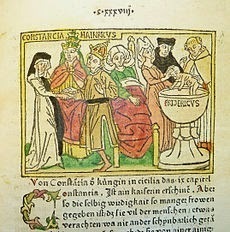
1186 Henry VI, the son and heir of the Holy Roman Emperor Frederick I, married Constance of Sicily.
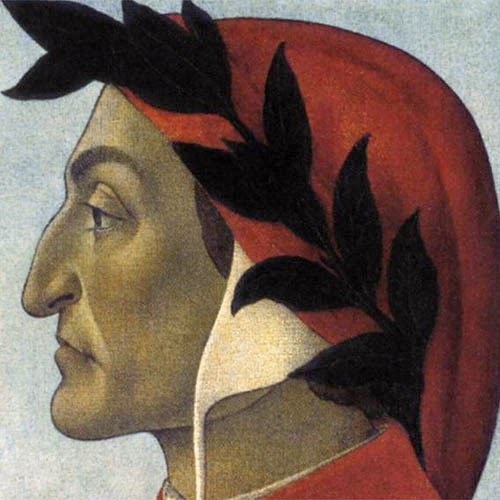
1302 Dante became a Florentine political exile because of his political activities that included the banishment of several rivals.
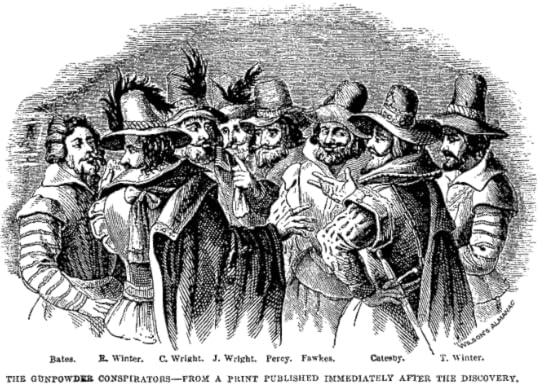
1606 Gunpowder Plot: The trial of Guy Fawkes and other conspirators began, ending with their execution on January 31.

484 BC, the temple of Castor and Pollux, the Heavenly Twins, was dedicated.

98 Trajan became Roman Emperor after the death of Nerva.

1186 Henry VI, the son and heir of the Holy Roman Emperor Frederick I, married Constance of Sicily.

1302 Dante became a Florentine political exile because of his political activities that included the banishment of several rivals.

1606 Gunpowder Plot: The trial of Guy Fawkes and other conspirators began, ending with their execution on January 31.
Published on January 27, 2015 03:00
January 26, 2015
History Trivia - King Edward III of England declared King of France
January 26

66: 5th recorded perihelion passage of Halley's Comet.

1316 Revolt in Wales against the authority of Edward II began.
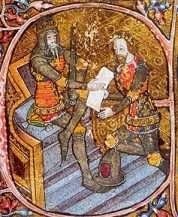
1340 King Edward III of England was declared King of France.

1531 An earthquake killed thousands in Lisbon, Portugal.

1564 The Council of Trent issued its conclusions in the Tridentinum, which established a distinction between Roman Catholicism and Protestantism.

66: 5th recorded perihelion passage of Halley's Comet.

1316 Revolt in Wales against the authority of Edward II began.

1340 King Edward III of England was declared King of France.

1531 An earthquake killed thousands in Lisbon, Portugal.

1564 The Council of Trent issued its conclusions in the Tridentinum, which established a distinction between Roman Catholicism and Protestantism.
Published on January 26, 2015 03:00
January 25, 2015
Mr. Chuckles catches up with Chickliterati Tracie "Twin Piques" Banister around the Wizard's Cauldron
 The Wizard speaks:
The Wizard speaks:Sometime last year, the name Tracie Banister was mooted here on the Cauldron as a name to watch out for in the world of the chickliterati. I contacted her and asked if she fancied a chat and she willingly agreed, but for one reason or another, it's taken a year to happen.
In the meantime, Tracie has rapidly gained a reputation on the circuit for effervescent, upbeat, feelgood chicklit.
Coinciding with the release of her hot new novel, "Twin Piques", I managed to track her down somewhere deep in the balmy savannahs of the southern states of America (the second native of Atlanta we've interviewed in the past fortnight), and we chatted on the Wizphone accompanied by the chirping of native birds and crickets awaking from their slumbers. Here's what Tracie had to say. Read more
Published on January 25, 2015 05:09
History Trivia - Henry VIII of England secretly married his second wife Anne Boleyn.
January 25

41 Tiberius Claudius Drusus was proclaimed as emperor by the Praetorian Guard. After a night of negotiation, Claudius was accepted as Roman Emperor by the Senate.
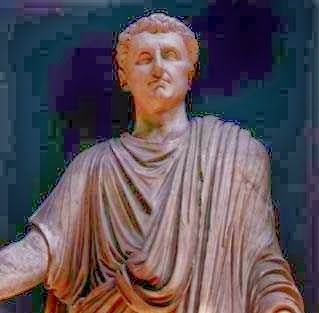
98 The Emperor Nerva died of natural causes.
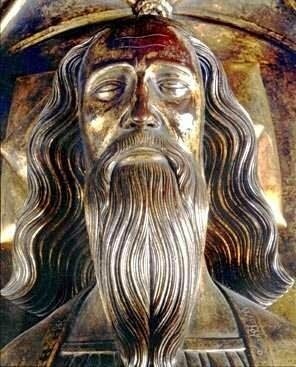
1327 Edward III became King of England.

1348 An earthquake destroyed Villach (Austria) that killed thousands.

1494 Alfonso II became King of Naples.

1533 Henry VIII of England secretly married his second wife Anne Boleyn.

41 Tiberius Claudius Drusus was proclaimed as emperor by the Praetorian Guard. After a night of negotiation, Claudius was accepted as Roman Emperor by the Senate.

98 The Emperor Nerva died of natural causes.

1327 Edward III became King of England.

1348 An earthquake destroyed Villach (Austria) that killed thousands.

1494 Alfonso II became King of Naples.

1533 Henry VIII of England secretly married his second wife Anne Boleyn.
Published on January 25, 2015 03:00
January 24, 2015
Sappho's New Poems: The Tangled Tale of Their Discovery
by Megan Gannon
Live Science
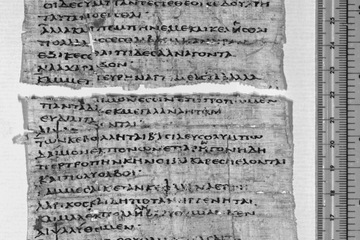 This multispectral image shows the papyrus fragment containing Sappho's "Brothers Poem" and "Kypris Poem." When it was whole, this sheet would have made up one column of a papyrus roll, equivalent to a page in a book.
This multispectral image shows the papyrus fragment containing Sappho's "Brothers Poem" and "Kypris Poem." When it was whole, this sheet would have made up one column of a papyrus roll, equivalent to a page in a book.
Credit: Courtesy of Dirk Obbink
Imagine that every copy of William Shakespeare's First Folio had been destroyed some 350 years ago. We might have heard tell of how great "Macbeth" once was on stage, but we couldn't perform it ourselves. Without the First Folio, we'd be deprived of at least half of Shakespeare's plays. No "Julius Caesar." No "Tempest." No "Twelfth Night."
Scholars of ancient literature find themselves in such a predicament with the Greek lyric poet Sappho, born in the late seventh century B.C. Her fame lives, but few of her poems survive.
Last year, however, classicists welcomed exciting news: Dirk Obbink, a leading papyrologist at the University of Oxford, announced that he had recovered substantial sections of two never-before seen poems by Sappho: one about her brothers, the second about unrequited love. [Image Gallery: Amazing Egyptian Discoveries]
Widely admired and studied in antiquity, Sappho was known as "the Tenth Muse," and her poetry was collected into nine books at the Library of Alexandria. But today, most of her first-person descriptions of erotic love and longing are read in tantalizing bits and pieces. Take the famous Fragment 130 (it's telling that Sappho's poems are labeled as numbered fragments in most 20th century translations), which reads in its entirety: "Once again Love, the loosener of limbs, shakes me, that sweet-bitter irresistible creature."
Obbink's discovery of the two new poems was hailed as a miracle, but in some circles, it was met with hesitation. Sappho's long-lost verses had been translated from an ancient papyrus that was in the hands of an anonymous collector in London. The manuscript's origins were unknown. Some archaeologists and historians worried it came from Egypt's black market, or feared that it could be a forgery akin to the Gospel of Jesus's Wife, a sensational manuscript that now seems to be a fake. Others were suspicious of the papyrus' apparent links to an American evangelical Christian collection of ancient texts.
From the beginning, Obbink maintained that the new Sappho papyrus has a legal, documented collecting history, but after a year of buzz, he finally revealed that provenance: the text had been folded up inside a tiny piece of glued-together papyri that was purchased by the anonymous collector at an auction in London in 2011.
Obbink made the announcement in a session at the annual meeting of the Society for Classical Studies (SCS) in New Orleans on Jan. 9, though he couldn't be at the event in person. (André Lardinois, a professor of Greek language and literature at Radboud University Nijmegen in the Netherlands, read the presentation, which is now available online.) In several interviews with Live Science, Obbink responded to some of the questions that still lingered over the papyrus' provenance.
From Egypt to Mississippi to London
Egyptian trash is, at times, a treasure trove for lost Greek poems. Old papyrus scrolls in ancient Egypt — from literary texts to tax receipts written in Greek — were often recycled and compressed into cartonnage, a material that resembles papier-mâché and was used to make mummy cases.
The so-called "Milan papyrus," for example, had been found in the cartonnage of a mummy looted by tomb robbers in Egypt. That scroll (which was purchased at auction for $1 million by a bank representing the University of Milan in the 1990s) gave scholars more than 100 new epigrams from the third century B.C. poet Posidippus.
representing the University of Milan in the 1990s) gave scholars more than 100 new epigrams from the third century B.C. poet Posidippus.
In November 2011, a group of 59 packets of Greek and Coptic papyrus fragments went up for auction at Christie's in London. The late archaeologist David M. Robinson had originally purchased the papyri from a dealer named Maguid Sameda in Cairo in 1954, before international and Egyptian laws prohibited such artifacts from leaving Egypt. Robinson bequeathed his collection to the University of Mississippi, but the school deaccessioned the papyri in the 1980s to acquire papers from a literary source closer to home: Mississippi-born novelist William Faulkner.
and Egyptian laws prohibited such artifacts from leaving Egypt. Robinson bequeathed his collection to the University of Mississippi, but the school deaccessioned the papyri in the 1980s to acquire papers from a literary source closer to home: Mississippi-born novelist William Faulkner.
The lot sold for 7,500 British pounds, or about $11,400. Obbink said the anonymous buyer called to ask for advice a couple of months after the auction, in January 2012. The new owner wanted to know if some of the compressed bits of papyri could be identified without peeling the layers apart.
Obbink said he went to see the packets for himself later that month. One small chunk of cartonnage appeared to contain multiple layers of papyrus, with fragments peeling off from the outside, Obbink said. The anonymous owner — who is a businessman, not a professional collector or academic — had his staff dissolve the tiny stack in warm water. From that pile, they found a folded-up, postcard-size manuscript with lines of text in ancient Greek. When Obbink later read the text, he said he knew he was looking at poems by Sappho.
collector or academic — had his staff dissolve the tiny stack in warm water. From that pile, they found a folded-up, postcard-size manuscript with lines of text in ancient Greek. When Obbink later read the text, he said he knew he was looking at poems by Sappho.
"As soon as I read the first line, with the meter and the name of Sappho's brother, I immediately knew what this was," he said.
In that first poem, "The Brothers Poem," Sappho worries about the safe return of her seafaring brother Charaxos, and wishes her other brother Larichos would grow up. It's unclear whom the speaker is addressing as the first few lines seem to be cut off. In the second, less complete poem, "The Kypris Poem," Sappho muses on the pain and paradox of unrequited love. In one particularly moving line, the speaker asks, "How can someone not be hurt and hurt again, Queen Aphrodite, by the person one loves — and wishes above all to ask back?"
The discovery gave Sappho scholars a wealth of new material to wrestle with; they're still debating how to reconstruct and interpret the new verses.
"We certainly have a fuller picture of her work and capability," Obbink said. "And the finding puts her up as a real person, because none of her poetry previously mentioned her family in the way that the 'Brothers Poem' does."
Obbink was confident in the papyrus' authenticity. The poems had Sappho's signature meter and language and, for the first time, her brothers' names, Charaxos and Larichos, which were only previously known from later biographical works about Sappho. Parts of the "Brothers Poem" and "Kypris Poem" also overlapped with previously published Sappho fragments. A carbon-14 dating of a portion of the papyrus returned a date of around A.D. 201. Though Obbink initially believed the cartonnage was part of a mummy casing, he later said it contained no traces of gesso or paint. That fact, combined with the age of the papyrus, suggests the cartonnage was more likely used for an industrial purpose, perhaps a book cover, he said.
The owner of the papyrus agreed to let Obbink publish the poems, so long as he could keep his anonymity. Obbink wrote an analysis of the text in The Times Literary Supplement and later in the papyrology journal Zeitschrift für Papyrologie und Epigraphik, or ZPE.
Collection anxiety
Yet, not all classicists and archaeologists were thrilled with the way the findings were presented. Some took to the blogosphere and opinion pages to fault Obbink for not addressing a key question: Where did the papyrus fragments come from? Obbink made no mention of the Christie's sale in those first publications.
"All of this has created unnecessary confusion," said Roberta Mazza, a lecturer in classics and ancient history at the University of Manchester. "If openness were there since the beginning, and we were given access to acquisition documents, access to images, we would have all been happier."
documents, access to images, we would have all been happier."
With a blog called Faces and Voices, Mazza is one of a handful of academics who have been tracking and pointing out discrepancies in each development about the newfound Sappho papyrus.
To understand why archaeologists get worked up about provenance even in the face of a thrilling discovery, one doesn't have to look far into recent history for an example. On the surface, the saga of the aforementioned Gospel of Jesus's Wife had similar beginnings to the discovery of the new Sappho papyrus.
In 2010, an anonymous collector asked Harvard University divinity professor Karen King to examine a papyrus fragment in his possession. Two years later, King announced that the business card-size manuscript contained a shocking bit of Coptic text: a reference to a "Mary" and the line, "Jesus said to them, 'My wife, she will be able to be my disciple.'"
card-size manuscript contained a shocking bit of Coptic text: a reference to a "Mary" and the line, "Jesus said to them, 'My wife, she will be able to be my disciple.'"
The dogma-shaking implication was that Mary Magdalene might have been Jesus' wife. But other scholars soon pointed out problematic aspects of the text — its bad handwriting, grammatical errors, and later, its striking similarities to a Coptic fragment of the Gospel of John that is now believed to be a fake. Though the Gospel of Jesus's Wife looked authentically old in lab tests, forgers can use ancient papyrus to create fake texts.
Documents related to a papyrus' collecting history could be forged, too. After King published a contract provided by the anonymous owner detailing his purchase of the papyrus, a Live Science investigation last year revealed that something was amiss. The anonymous owner of the papyrus claimed to have purchased the papyrus from a now-deceased man whose family said he never collected antiquities. According to The Atlantic, the current consensus among academics is that the text is a forgery.
Questions of authenticity aside, the specter of looting also loomed over the new Sappho papyrus. Douglas Boin, an archaeologist at Saint Louis University, wrote an op-ed in The New York Times criticizing the lack of transparency with regard to the poems' provenance, in light of the widespread looting of Egyptian archaeological sites after the political unrest that began in the region in 2011. Even if the Sappho papyrus had a perfectly legal collecting history, "indifference to the provenance of a cultural treasure has sent tacit and dangerous encouragement to traffickers of looted artifacts," Boin argued.
Archaeologist Francesca Tronchin wrote in a post on the blog Classical Archaeology News last year that the "publication of these newly discovered fragments has a troubling, yet circumstantial, timing," given the degree of looting in Egypt.
Scattered Sappho fragments
Obbink said he knew the Sappho papyrus had a legal, documented provenance all along.
"There's no question in my mind about where the piece came from," Obbink told Live Science. "I can absolutely guarantee that there's no question about that."
So why wait a year to reveal its collecting history? For one, Obbink said he had been invited to take part in the panel at the 2015 SCS meeting specifically to address the text's provenance, with the understanding that he would be announcing new information. He said he thought the meeting would be an appropriate, scholarly venue to talk about the collecting history.
Those intervening months also allowed Obbink to try to track down other papyri pieces that may be linked to the new Sappho poems. Robinson's total collection at the University of Mississippi included many more items than the 59 packets from the 2011 Christie's sale. Through various sales, these texts have dispersed widely across collections in Europe and the United States over the past few decades. Obbink said he wanted to check if any more Sappho fragments were hidden in those scattered manuscripts. [The Holy Land: 7 Amazing Archaeological Finds]
"The Robinson collection hadn't been thoroughly looked at since it was all together," Obbink said. "There was a quite extensive paper trail to try to track down. I had to see if there were any other pieces that could be recovered and published with the group. That didn't happen overnight."
Obbink did not actually find any more Sappho pieces from earlier dispersals of Robinson's collection, but, he added, "If someone else had identified other fragments in the collection, that would have interfered with my research."
Some time between the 2011 Christie's sale and Obbink's identification of the poems as Sappho's, the anonymous owner had traded about 20 smaller fragments from the same piece of cartonnage where the Sappho papyrus was pulled from. These fragments, which the owner deemed insignificant, made their way through the London market into the Green Collection in Oklahoma City.
The Green family founded the arts-and-crafts chain Hobby Lobby and amassed a fortune worth billions. They are evangelical Christians, and a few years ago, they founded the Green Collection and the Green Scholars Initiative to assemble and study a massive collection of rare ancient texts. The hope is that they'll find biblical manuscripts to display in the $800 million Museum of the Bible they are currently building near the National Mall in Washington, D.C. After Obbink figured out that some pieces of the Sappho cartonnage ended up in the Green Collection, he got permission to look at those 20 fragments. He was able to identify them as additional Sappho verses that overlap with already known fragments of her poetry.
Lingering questions
Work on the new Sappho papyrus isn't finished. Obbink said he would be in Oxford today (Jan. 23) to further examine the manuscript with a noninvasive technique called multispectral imaging, which allows researchers to take very high-resolution photographs with multiple wavelengths of light. Better images of the text could help clarify some of the uncertain letters, which could change how scholars read the poems. In the coming months, Obbink said the plan is to make the collecting documents and related photographs of the London Sappho papyrus available online, including letters, transcripts and other papers from people, including Robinson, who worked on this collection early on.
Despite the promise of transparency, Obbink might not appease all of his critics still reeling from months of confusion, but he thinks there is an explanation to most of the questions that have cropped up in the blogosphere.
One of the first people to report on the new Sappho papyrus was author and historian Bettany Hughes. In a column in The Sunday Times of London, Hughes wrote that the papyrus seems to have been originally owned by "a high-ranking German officer." Some, like archaeologist Paul Barford, who blogs about cultural heritage issues, wondered whether she was suggesting the manuscript was Nazi loot. Others, including Mazza and David Gill of Looting Matters, have questioned why this "German officer" has disappeared now from every other account of the papyrus' provenance. But Obbink characterized Hughes' story as a "fictionalization" and an "imaginative fantasy."
of the papyrus' provenance. But Obbink characterized Hughes' story as a "fictionalization" and an "imaginative fantasy."
"Bettany Hughes never saw the papyrus," Obbink said. "I never discussed the ownership with her. She published the story without consulting me." (Hughes did not respond to a request for comment.)
Some skeptics raised the possibility that the Sappho papyrus might not have belonged to the Robinson collection at all — that instead it may have been tucked in with the lot before the Christie's sale. But Obbink says the piece does have its original Robinson collection inventory number attached to it. That will hopefully be made clear when the documents go online. [In Photos: Amazing Ruins of the Ancient World]
Inventory numbers in Obbink's original paper gave away the fact that the new Sappho papyrus was somehow connected to fragments in the Green Collection. That set off alarm bells for some scholars, such as Mazza, who outlined some of her worries in a presentation at an art crime conference in Italy last summer. Her concerns include texts that may be lost or ignored, and the cartonnage mummy masks that may be destroyed, in the search for biblical manuscripts.
Tim Whitmarsh, a classicist at the University of Cambridge, has similar apprehensions about the Greens' collecting habits.
"I don't think many of us are in a position to know what's really going on, and I don't want to allege mischief," Whitmarsh said. "I just have a nagging fear that secretive, billionaire-backed evangelicals questing after original Bibles aren't likely to be the best servants of disinterested classical scholarship."
But Obbink shot down any theories that the Green Collection was somehow linked to the anonymous collector in London. He said the London collector does not know the Greens, and the fragments were traded through at least one intermediary dealer. Obbink (who was listed as a co-editor on the Green Scholars Initiative's papyri series) said he didn't have a problem working with the Green Collection either, though he said its leaders were not overly keen on him working on the Sappho fragments because these poems weren't directly related to Christian history.
"The only real connection is that the monks of the Middle Ages may have conspired to destroy Sappho's writings since her brand of pagan sensuality was not compatible with Christianity — at a certain point in time anyway," Obbink said. "That's not a story they're interested in telling, but they didn’t try to stop me from publishing it anyway."
Obbink credited the Green Collection for preserving the Sappho fragments, and said he would have been more upset if those bits of text had gone missing or were lost.
"They could have gone into the hands of someone who did want to keep them away from other people," Obbink said.
This is where he might find common ground with his critics. The anxiety that more Sappho fragments could be hidden in anonymous, private collections is what turns some historians into amateur detectives.
"These little objects we are talking about, which range from Sappho verses to ancient tax receipts, are the basis of our study of history," Mazza said. "It's our cultural heritage. It may be the property of an institution or of a collector, but they are at the basis of what historians and classicists are doing. If we lose track of these materials, we lose track of our history — a piece of our history goes lost."
Live Science
 This multispectral image shows the papyrus fragment containing Sappho's "Brothers Poem" and "Kypris Poem." When it was whole, this sheet would have made up one column of a papyrus roll, equivalent to a page in a book.
This multispectral image shows the papyrus fragment containing Sappho's "Brothers Poem" and "Kypris Poem." When it was whole, this sheet would have made up one column of a papyrus roll, equivalent to a page in a book.Credit: Courtesy of Dirk Obbink
Imagine that every copy of William Shakespeare's First Folio had been destroyed some 350 years ago. We might have heard tell of how great "Macbeth" once was on stage, but we couldn't perform it ourselves. Without the First Folio, we'd be deprived of at least half of Shakespeare's plays. No "Julius Caesar." No "Tempest." No "Twelfth Night."
Scholars of ancient literature find themselves in such a predicament with the Greek lyric poet Sappho, born in the late seventh century B.C. Her fame lives, but few of her poems survive.
Last year, however, classicists welcomed exciting news: Dirk Obbink, a leading papyrologist at the University of Oxford, announced that he had recovered substantial sections of two never-before seen poems by Sappho: one about her brothers, the second about unrequited love. [Image Gallery: Amazing Egyptian Discoveries]
Widely admired and studied in antiquity, Sappho was known as "the Tenth Muse," and her poetry was collected into nine books at the Library of Alexandria. But today, most of her first-person descriptions of erotic love and longing are read in tantalizing bits and pieces. Take the famous Fragment 130 (it's telling that Sappho's poems are labeled as numbered fragments in most 20th century translations), which reads in its entirety: "Once again Love, the loosener of limbs, shakes me, that sweet-bitter irresistible creature."
Obbink's discovery of the two new poems was hailed as a miracle, but in some circles, it was met with hesitation. Sappho's long-lost verses had been translated from an ancient papyrus that was in the hands of an anonymous collector in London. The manuscript's origins were unknown. Some archaeologists and historians worried it came from Egypt's black market, or feared that it could be a forgery akin to the Gospel of Jesus's Wife, a sensational manuscript that now seems to be a fake. Others were suspicious of the papyrus' apparent links to an American evangelical Christian collection of ancient texts.
From the beginning, Obbink maintained that the new Sappho papyrus has a legal, documented collecting history, but after a year of buzz, he finally revealed that provenance: the text had been folded up inside a tiny piece of glued-together papyri that was purchased by the anonymous collector at an auction in London in 2011.
Obbink made the announcement in a session at the annual meeting of the Society for Classical Studies (SCS) in New Orleans on Jan. 9, though he couldn't be at the event in person. (André Lardinois, a professor of Greek language and literature at Radboud University Nijmegen in the Netherlands, read the presentation, which is now available online.) In several interviews with Live Science, Obbink responded to some of the questions that still lingered over the papyrus' provenance.
From Egypt to Mississippi to London
Egyptian trash is, at times, a treasure trove for lost Greek poems. Old papyrus scrolls in ancient Egypt — from literary texts to tax receipts written in Greek — were often recycled and compressed into cartonnage, a material that resembles papier-mâché and was used to make mummy cases.
The so-called "Milan papyrus," for example, had been found in the cartonnage of a mummy looted by tomb robbers in Egypt. That scroll (which was purchased at auction for $1 million by a bank
 representing the University of Milan in the 1990s) gave scholars more than 100 new epigrams from the third century B.C. poet Posidippus.
representing the University of Milan in the 1990s) gave scholars more than 100 new epigrams from the third century B.C. poet Posidippus.In November 2011, a group of 59 packets of Greek and Coptic papyrus fragments went up for auction at Christie's in London. The late archaeologist David M. Robinson had originally purchased the papyri from a dealer named Maguid Sameda in Cairo in 1954, before international
 and Egyptian laws prohibited such artifacts from leaving Egypt. Robinson bequeathed his collection to the University of Mississippi, but the school deaccessioned the papyri in the 1980s to acquire papers from a literary source closer to home: Mississippi-born novelist William Faulkner.
and Egyptian laws prohibited such artifacts from leaving Egypt. Robinson bequeathed his collection to the University of Mississippi, but the school deaccessioned the papyri in the 1980s to acquire papers from a literary source closer to home: Mississippi-born novelist William Faulkner.The lot sold for 7,500 British pounds, or about $11,400. Obbink said the anonymous buyer called to ask for advice a couple of months after the auction, in January 2012. The new owner wanted to know if some of the compressed bits of papyri could be identified without peeling the layers apart.
Obbink said he went to see the packets for himself later that month. One small chunk of cartonnage appeared to contain multiple layers of papyrus, with fragments peeling off from the outside, Obbink said. The anonymous owner — who is a businessman, not a professional
 collector or academic — had his staff dissolve the tiny stack in warm water. From that pile, they found a folded-up, postcard-size manuscript with lines of text in ancient Greek. When Obbink later read the text, he said he knew he was looking at poems by Sappho.
collector or academic — had his staff dissolve the tiny stack in warm water. From that pile, they found a folded-up, postcard-size manuscript with lines of text in ancient Greek. When Obbink later read the text, he said he knew he was looking at poems by Sappho."As soon as I read the first line, with the meter and the name of Sappho's brother, I immediately knew what this was," he said.
In that first poem, "The Brothers Poem," Sappho worries about the safe return of her seafaring brother Charaxos, and wishes her other brother Larichos would grow up. It's unclear whom the speaker is addressing as the first few lines seem to be cut off. In the second, less complete poem, "The Kypris Poem," Sappho muses on the pain and paradox of unrequited love. In one particularly moving line, the speaker asks, "How can someone not be hurt and hurt again, Queen Aphrodite, by the person one loves — and wishes above all to ask back?"
The discovery gave Sappho scholars a wealth of new material to wrestle with; they're still debating how to reconstruct and interpret the new verses.
"We certainly have a fuller picture of her work and capability," Obbink said. "And the finding puts her up as a real person, because none of her poetry previously mentioned her family in the way that the 'Brothers Poem' does."
Obbink was confident in the papyrus' authenticity. The poems had Sappho's signature meter and language and, for the first time, her brothers' names, Charaxos and Larichos, which were only previously known from later biographical works about Sappho. Parts of the "Brothers Poem" and "Kypris Poem" also overlapped with previously published Sappho fragments. A carbon-14 dating of a portion of the papyrus returned a date of around A.D. 201. Though Obbink initially believed the cartonnage was part of a mummy casing, he later said it contained no traces of gesso or paint. That fact, combined with the age of the papyrus, suggests the cartonnage was more likely used for an industrial purpose, perhaps a book cover, he said.
The owner of the papyrus agreed to let Obbink publish the poems, so long as he could keep his anonymity. Obbink wrote an analysis of the text in The Times Literary Supplement and later in the papyrology journal Zeitschrift für Papyrologie und Epigraphik, or ZPE.
Collection anxiety
Yet, not all classicists and archaeologists were thrilled with the way the findings were presented. Some took to the blogosphere and opinion pages to fault Obbink for not addressing a key question: Where did the papyrus fragments come from? Obbink made no mention of the Christie's sale in those first publications.
"All of this has created unnecessary confusion," said Roberta Mazza, a lecturer in classics and ancient history at the University of Manchester. "If openness were there since the beginning, and we were given access to acquisition
 documents, access to images, we would have all been happier."
documents, access to images, we would have all been happier."With a blog called Faces and Voices, Mazza is one of a handful of academics who have been tracking and pointing out discrepancies in each development about the newfound Sappho papyrus.
To understand why archaeologists get worked up about provenance even in the face of a thrilling discovery, one doesn't have to look far into recent history for an example. On the surface, the saga of the aforementioned Gospel of Jesus's Wife had similar beginnings to the discovery of the new Sappho papyrus.
In 2010, an anonymous collector asked Harvard University divinity professor Karen King to examine a papyrus fragment in his possession. Two years later, King announced that the business
 card-size manuscript contained a shocking bit of Coptic text: a reference to a "Mary" and the line, "Jesus said to them, 'My wife, she will be able to be my disciple.'"
card-size manuscript contained a shocking bit of Coptic text: a reference to a "Mary" and the line, "Jesus said to them, 'My wife, she will be able to be my disciple.'"The dogma-shaking implication was that Mary Magdalene might have been Jesus' wife. But other scholars soon pointed out problematic aspects of the text — its bad handwriting, grammatical errors, and later, its striking similarities to a Coptic fragment of the Gospel of John that is now believed to be a fake. Though the Gospel of Jesus's Wife looked authentically old in lab tests, forgers can use ancient papyrus to create fake texts.
Documents related to a papyrus' collecting history could be forged, too. After King published a contract provided by the anonymous owner detailing his purchase of the papyrus, a Live Science investigation last year revealed that something was amiss. The anonymous owner of the papyrus claimed to have purchased the papyrus from a now-deceased man whose family said he never collected antiquities. According to The Atlantic, the current consensus among academics is that the text is a forgery.
Questions of authenticity aside, the specter of looting also loomed over the new Sappho papyrus. Douglas Boin, an archaeologist at Saint Louis University, wrote an op-ed in The New York Times criticizing the lack of transparency with regard to the poems' provenance, in light of the widespread looting of Egyptian archaeological sites after the political unrest that began in the region in 2011. Even if the Sappho papyrus had a perfectly legal collecting history, "indifference to the provenance of a cultural treasure has sent tacit and dangerous encouragement to traffickers of looted artifacts," Boin argued.
Archaeologist Francesca Tronchin wrote in a post on the blog Classical Archaeology News last year that the "publication of these newly discovered fragments has a troubling, yet circumstantial, timing," given the degree of looting in Egypt.
Scattered Sappho fragments
Obbink said he knew the Sappho papyrus had a legal, documented provenance all along.
"There's no question in my mind about where the piece came from," Obbink told Live Science. "I can absolutely guarantee that there's no question about that."
So why wait a year to reveal its collecting history? For one, Obbink said he had been invited to take part in the panel at the 2015 SCS meeting specifically to address the text's provenance, with the understanding that he would be announcing new information. He said he thought the meeting would be an appropriate, scholarly venue to talk about the collecting history.
Those intervening months also allowed Obbink to try to track down other papyri pieces that may be linked to the new Sappho poems. Robinson's total collection at the University of Mississippi included many more items than the 59 packets from the 2011 Christie's sale. Through various sales, these texts have dispersed widely across collections in Europe and the United States over the past few decades. Obbink said he wanted to check if any more Sappho fragments were hidden in those scattered manuscripts. [The Holy Land: 7 Amazing Archaeological Finds]
"The Robinson collection hadn't been thoroughly looked at since it was all together," Obbink said. "There was a quite extensive paper trail to try to track down. I had to see if there were any other pieces that could be recovered and published with the group. That didn't happen overnight."
Obbink did not actually find any more Sappho pieces from earlier dispersals of Robinson's collection, but, he added, "If someone else had identified other fragments in the collection, that would have interfered with my research."
Some time between the 2011 Christie's sale and Obbink's identification of the poems as Sappho's, the anonymous owner had traded about 20 smaller fragments from the same piece of cartonnage where the Sappho papyrus was pulled from. These fragments, which the owner deemed insignificant, made their way through the London market into the Green Collection in Oklahoma City.
The Green family founded the arts-and-crafts chain Hobby Lobby and amassed a fortune worth billions. They are evangelical Christians, and a few years ago, they founded the Green Collection and the Green Scholars Initiative to assemble and study a massive collection of rare ancient texts. The hope is that they'll find biblical manuscripts to display in the $800 million Museum of the Bible they are currently building near the National Mall in Washington, D.C. After Obbink figured out that some pieces of the Sappho cartonnage ended up in the Green Collection, he got permission to look at those 20 fragments. He was able to identify them as additional Sappho verses that overlap with already known fragments of her poetry.
Lingering questions
Work on the new Sappho papyrus isn't finished. Obbink said he would be in Oxford today (Jan. 23) to further examine the manuscript with a noninvasive technique called multispectral imaging, which allows researchers to take very high-resolution photographs with multiple wavelengths of light. Better images of the text could help clarify some of the uncertain letters, which could change how scholars read the poems. In the coming months, Obbink said the plan is to make the collecting documents and related photographs of the London Sappho papyrus available online, including letters, transcripts and other papers from people, including Robinson, who worked on this collection early on.
Despite the promise of transparency, Obbink might not appease all of his critics still reeling from months of confusion, but he thinks there is an explanation to most of the questions that have cropped up in the blogosphere.
One of the first people to report on the new Sappho papyrus was author and historian Bettany Hughes. In a column in The Sunday Times of London, Hughes wrote that the papyrus seems to have been originally owned by "a high-ranking German officer." Some, like archaeologist Paul Barford, who blogs about cultural heritage issues, wondered whether she was suggesting the manuscript was Nazi loot. Others, including Mazza and David Gill of Looting Matters, have questioned why this "German officer" has disappeared now from every other account
 of the papyrus' provenance. But Obbink characterized Hughes' story as a "fictionalization" and an "imaginative fantasy."
of the papyrus' provenance. But Obbink characterized Hughes' story as a "fictionalization" and an "imaginative fantasy.""Bettany Hughes never saw the papyrus," Obbink said. "I never discussed the ownership with her. She published the story without consulting me." (Hughes did not respond to a request for comment.)
Some skeptics raised the possibility that the Sappho papyrus might not have belonged to the Robinson collection at all — that instead it may have been tucked in with the lot before the Christie's sale. But Obbink says the piece does have its original Robinson collection inventory number attached to it. That will hopefully be made clear when the documents go online. [In Photos: Amazing Ruins of the Ancient World]
Inventory numbers in Obbink's original paper gave away the fact that the new Sappho papyrus was somehow connected to fragments in the Green Collection. That set off alarm bells for some scholars, such as Mazza, who outlined some of her worries in a presentation at an art crime conference in Italy last summer. Her concerns include texts that may be lost or ignored, and the cartonnage mummy masks that may be destroyed, in the search for biblical manuscripts.
Tim Whitmarsh, a classicist at the University of Cambridge, has similar apprehensions about the Greens' collecting habits.
"I don't think many of us are in a position to know what's really going on, and I don't want to allege mischief," Whitmarsh said. "I just have a nagging fear that secretive, billionaire-backed evangelicals questing after original Bibles aren't likely to be the best servants of disinterested classical scholarship."
But Obbink shot down any theories that the Green Collection was somehow linked to the anonymous collector in London. He said the London collector does not know the Greens, and the fragments were traded through at least one intermediary dealer. Obbink (who was listed as a co-editor on the Green Scholars Initiative's papyri series) said he didn't have a problem working with the Green Collection either, though he said its leaders were not overly keen on him working on the Sappho fragments because these poems weren't directly related to Christian history.
"The only real connection is that the monks of the Middle Ages may have conspired to destroy Sappho's writings since her brand of pagan sensuality was not compatible with Christianity — at a certain point in time anyway," Obbink said. "That's not a story they're interested in telling, but they didn’t try to stop me from publishing it anyway."
Obbink credited the Green Collection for preserving the Sappho fragments, and said he would have been more upset if those bits of text had gone missing or were lost.
"They could have gone into the hands of someone who did want to keep them away from other people," Obbink said.
This is where he might find common ground with his critics. The anxiety that more Sappho fragments could be hidden in anonymous, private collections is what turns some historians into amateur detectives.
"These little objects we are talking about, which range from Sappho verses to ancient tax receipts, are the basis of our study of history," Mazza said. "It's our cultural heritage. It may be the property of an institution or of a collector, but they are at the basis of what historians and classicists are doing. If we lose track of these materials, we lose track of our history — a piece of our history goes lost."
Published on January 24, 2015 06:45
Some things you didn't know, and didn't know you wanted to know, about author Morgan Songer

Interesting stuff about Morgan:
My favorite movie series is Aliens, Sigourney Weaver has been/ will always be my idol and role model.
My life goal is to free dive with great white sharks.
My guilty pleasure music is Nick Lachey, he just gets me!
Monster's Ink and Monster's University makes me cry like a baby, every time!
I live in Colorado but have never been skiing!
I am a bit of every character in my short stories/books.

Morgan has been an author all of her life. Even as a child, she was always happy living in a fantasy filled world, so much so that she found herself needing the rules of the real world to make sense. In doing so, Morgan found a way to connect the real with the unreal, the natural with the unnatural.
In Morgan's world of fiction, legends and myths are given reason, monsters given personalities, and symbols for hope are twisted for profit and selfish glory. All this is embedded in true emotions and uncomfortable situations, where her characters are forced to make drastic choices to survive.
Follow Morgan down the rabbit hole where the weird meet the unexpected in a world where wild things not only go bump in the night, but roam freely. This is a world that is carried through centuries, infusing Earth with an unending heritage of magic and science.

Amazon author page

Follow Morgan:
Blog
Published on January 24, 2015 04:00
History Trivia - Caligula murdered
January 24
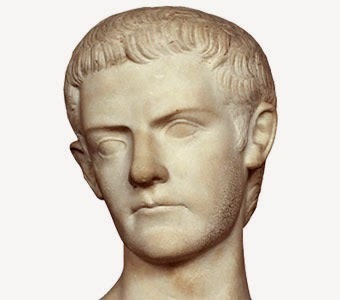
41 Caligula was murdered along with his wife and infant child by a Praetorian tribune while attending the Palatine games. Claudius succeeded his nephew.

76 Emperor Hadrian was born.
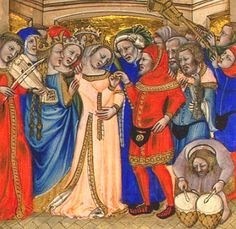
1328 King Edward III of England married Philippa of Henegouwen.


41 Caligula was murdered along with his wife and infant child by a Praetorian tribune while attending the Palatine games. Claudius succeeded his nephew.

76 Emperor Hadrian was born.

1328 King Edward III of England married Philippa of Henegouwen.

Published on January 24, 2015 03:00
January 23, 2015
Red Seat Numbers Found on Rome's Colosseum
 by Rossella Lorenzi
by Rossella Lorenzi Discovery News
Traces of red painted numbers have been found on the arches of Rome’s Colosseum during the ongoing $33 million restoration work aimed at repairing damage suffered by the 2,000-year-old monument since the Middle Ages.
Similar to today’s stadium seating systems, the numbers — written according to the system used in ancient Rome, using letters of the Latin alphabet such as X, L, V, I — stood on the entrance gate arches, allowing an easier access to the seats.
Rome’s Colosseum a Condominium in Medieval Times
First carved in the travertine stones, the numbers were then painted in red, so that people could easily see them from a distance.
There were 76 public numbered entrances, plus four special un-numbered gates. Two were reserved to the emperor, senators, magistrates, wealthy patricians, and the Vestal Virgins, priestesses responsible for maintaining the sacred fire within the Temple of Vesta. A gate was used for the dead — gladiators and wild beasts — while another was used by gladiators parading prior to the beginning of the combats.
The numbered entrance gates were the first step of a complex crowd control system which allowed tens of thousands of spectators to smoothly enter the amphitheater and quickly find their seat.
“The 50,000 spectators had a ticket that said which numbered gate arch they were supposed to enter. Inside the arena, there were other numbers to help people access their seats, which were assigned according to social class,” the monument director Rossella Rea said.
Although entrance was free for all, a strict plan regulated where one could seat on the amphitheater’s four levels of seating.
Roman Gladiators Drank Ash Energy Drink
The best seat belonged to the emperor who sat in the first tier in the Emperor’s Box; the first level was also reserved to senator, magistrates and Vestal Virgins. On the second tier sat the upper class, on the third the ordinary Roman citizens, while women and the poor stood or sat on wooden benches in the fourth, top tier.
The traces of red painted numbers represent an “exceptional finding,” according to Rea.
“It was believed the paint would not have survived at all,” Rea said.
Deriving from iron oxide and clay minerals, the red color could be used without any binding material.
“As the color could withstand two-three years, it had to be periodically applied on the carved numbers,” restorer Cinzia Conti, said.
Gladiator Chews Out Ref From Grave
Commissioned by the Emperor Vespasian in A.D. 72, the Colosseum was opened by his son Titus in A.D. 80 with 100 days of gladiatorial bouts, beast battles and public executions.
It was the largest building in Rome, covering a little over half an acre and standing 164 feet high against the Roman skyline.
It continued to provide the ancient Romans “panem et circenses” — bread and circuses — until shows were banned in the fifth century, about 40 years before the fall of the Roman Empire.
Rea’s team expects to find other traces of colored numbers inside the monument as the restoration proceeds.
Image: Traces of red color in the Roman number X (10). Credit: Soprintendenza Speciale per i Beni Archeologici di Roma.
Published on January 23, 2015 07:16
King Tut's Beard Broken Off, Wrongly Glued Back on
 by Rossella Lorenzi
by Rossella Lorenzi Discovery News
Inappropriate epoxy glue is now holding together the long, narrow, blue and gold beard on the famous mask of King Tutankhamun, according a report in the Arabic news site Al Araby Al Jadeed.
Braided like a pigtail with the end jutting forward, the beard was reportedly detached from the over 3,300-year-old mask during a cleaning incident last October at the Egyptian Museum in Cairo, where the artifact is one of the top attractions.
Weird Facts About King Tut and His Mummy
A museum employee, who asked for anonymity for fear of reprisals, told Al Araby Al Jadeed that the beard was unintentionally severed from the chin during ordinary dusting.
Three of the museum’s conservators confirmed the incident to the Associated Press, although they gave different accounts as to whether the beard was knocked off during cleaning or was removed because it was loose.
They all agreed that the beard was glued back on improperly.
Rather than following the regular procedures reporting the damage to the Ministry of Antiquities and send the priceless artifact to the restoration lab, someone opted for a DIY procedure, Al Araby Al Jadeed wrote.
Tut’s Funeral: Burying the Boy King
The beard was fixed with quick drying epoxy that cannot unstuck given its very high adhesive property. Indeed, the material is used for attaching on metal or stone.
Moreover, the glue was used abundantly, causing it to dramatically flow along the beard and chin.
According to the Arabic news site, which has published a picture to show “the presence of a foreign substance between the mask and chin,” it was then decided to remove the residue adhesive with a spatula, only doing more damaging as scratches are now visible.
King Tut’s Chariots: Ferraris of Ancient Egypt
The incident, according to the news site, is the reason why the room housing the priceless golden mask is dimmer than the rest of the museum.
“Instructions were given in order to avoid showing the face and the damage in the chin area,” Al Araby Al Jadeed wrote.
The Egyptian museum has not yet confirmed the reports.
Image: King Tut mask at the Egyptian Museum in Cairo before the alleged incident. Credit: Bjørn Christian Tørrissen/Wikimedia Commons.
Published on January 23, 2015 07:11
History Trivia - First English Parliament formally convenes
January 23

27 BC, Augustus Caesar (Octavian) founded the Roman Empire that would last until A.D. 476. Octavian was granted the title 'Augustus', meaning lofty or serene, by the Roman senate.

1265 First English Parliament formally convened.

1510 18 year old Henry VIII of England appeared incognito in the lists at Richmond, and was applauded for his jousting before he revealed his identity.

1533 Anne Boleyn, second wife of Henry VIII of England, discovered she was pregnant.


27 BC, Augustus Caesar (Octavian) founded the Roman Empire that would last until A.D. 476. Octavian was granted the title 'Augustus', meaning lofty or serene, by the Roman senate.

1265 First English Parliament formally convened.

1510 18 year old Henry VIII of England appeared incognito in the lists at Richmond, and was applauded for his jousting before he revealed his identity.

1533 Anne Boleyn, second wife of Henry VIII of England, discovered she was pregnant.

Published on January 23, 2015 03:00



